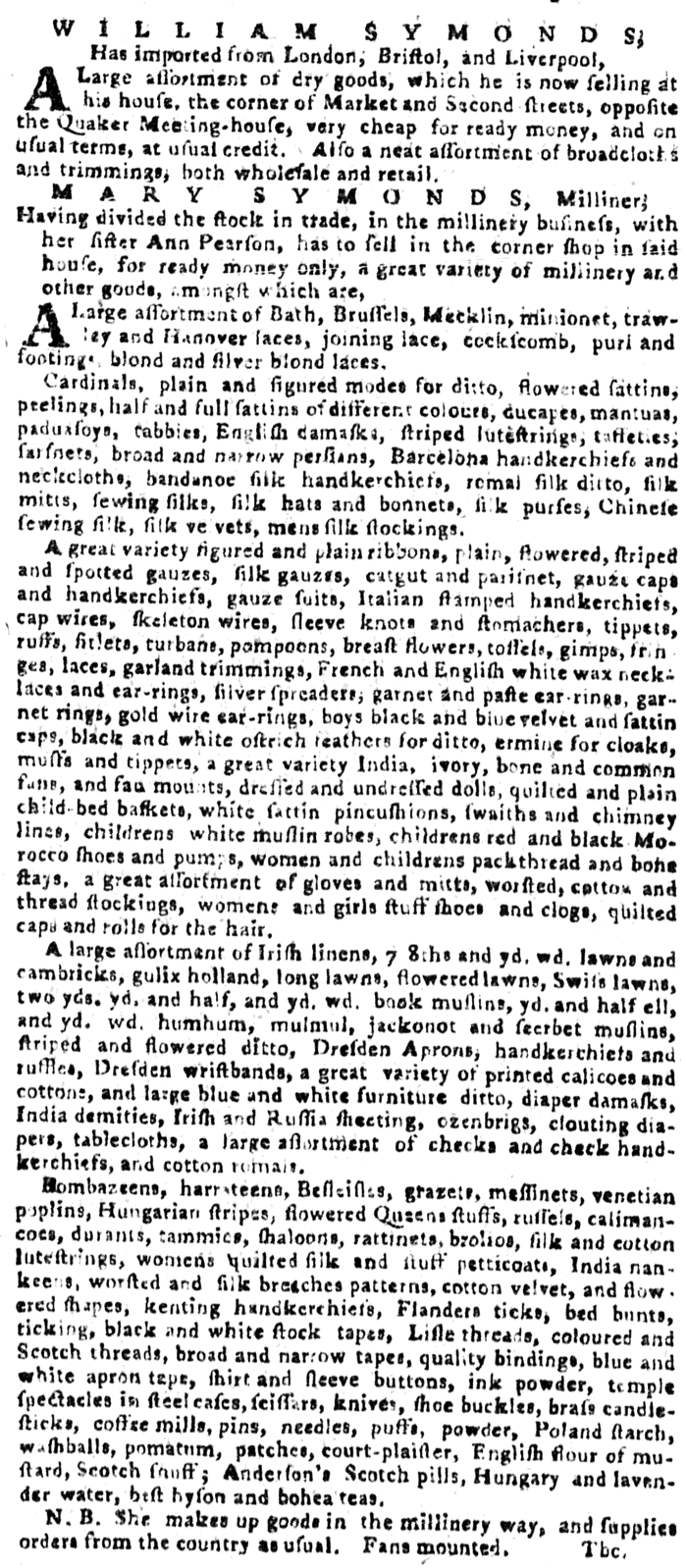GUEST CURATOR: Elizabeth Curley
What was advertised in a colonial newspaper 250 years ago this week?

“She makes up goods in the millinery way.”
Mary Symonds owned a corner shop and placed a very lengthy advertisement in the Pennsylvania Gazette. Symonds was a milliner, which is “a person who designs, makes, trims, or sells women’s hats.”
Symonds describes the different materials and trimmings she sold, such as “a great variety of printed calicoes and cottons” and “A great variety of figured and plain ribbons” along with “sattins of different colours.” Unfortunately, I could not identify a lot of descriptive words, but I could tell that all those paragraphs were different trimmings, fabrics, and their descriptions.
In the 1760s all types of people – from the rich to the poor – wore hats. The difference, however, was the material and how much detail was put into them. Hats could be extremely detailed, depending on how much money the colonist could pay. Milliners could add ribbons and other trimmings like the ones in Symonds’ advertisement if customers so chose. Like today, how people dressed was a status symbol that was very important to American colonists. Whether her customers had enough money to wear a different hat every day or wore the same hat every day, they could keep Symonds in business for years to come.
I was curious about how hats in America and England looked in the 1760s. These paintings all show women with hats during the period.

**********

**********

**********
ADDITIONAL COMMENTARY: Carl Robert Keyes
There’s so much going on in this advertisement that it’s hard to know where to begin. Indeed, an entire chapter or more could be devoted to teasing out the various aspects of this advertisement. As Elizabeth notes, average readers today do not recognize the various kinds of textiles and trimming that Symonds listed. Material culture specialists, on the other hand, have written entire books about the quality and characteristics, production and consumption, and social and cultural meanings of these fabrics and accoutrements.
Mary Symonds operated her shop in the same location as William Symonds, but this advertisement suggests that they operated their businesses independently of each other. Although William’s business appeared first in the advertisement, Mary’s list of wares comprised a significantly lengthier section. Mary also noted that she had once been in partnership with “her sister Ann Pearson,” a milliner who ran her own advertisements in Philadelphia’s newspapers. The two sisters ran a series of advertisements in previous weeks announcing that they were dissolving their partnership and dividing the merchandise in anticipation of running separate shops. Such advertisements help to demonstrate that some colonial women operated businesses independently or in partnership with other women. Male relations, including William Symonds, did not necessarily oversee women who acted as retailers.
There’s another reason I was excited when Elizabeth selected this advertisement. I’ve identified only a handful of eighteenth-century trade cards and billheads distributed by women. Mary Symonds is the only female advertiser from Philadelphia with a trade card still extant (as part of the Cadwalader Collection at the Historical Society of Pennsylvania). Her trade card, listed a broad range of millinery supplies similar to what appeared in her newspaper advertisements, circulated in 1770 and perhaps even earlier. It included a border and her name in a rococo-style cartouche. Overall, it was less ornate than some of the trade cards distributed by male advertisers, but it was the most impressive trade card known to have been used by a female advertiser. It appears that Symonds took pride in her business and invested in it accordingly.

The copy at the HSP has been dated to 1770 because a receipted bill appears on the reverse. On five different occasions in October and November 1770, somebody – probably Symonds herself – recorded more than a dozen purchases made by “Mrs. Cadwalader” (including “White Gloves,” a “Lace Cap,” and several yards of satin and muslin) amounting to more than £20. This receipted bill indicates that Symonds “Recevd the Contents in full” on November 22, 1770.
